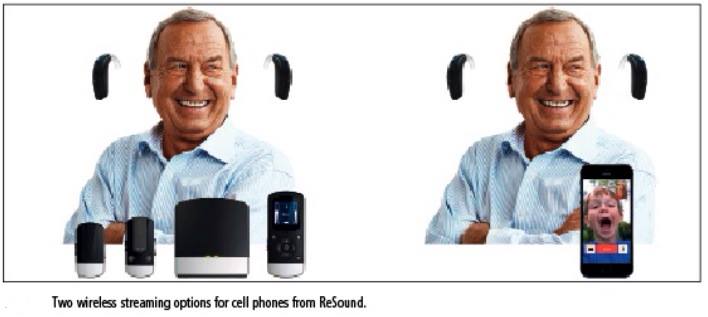Blog
-

Speech Intelligibility Benefits of FaceTime: Advantages for Everybody.
 19 Aug , 2016
19 Aug , 2016
(This study shows that the benefits of audio streamed bilaterally via MFi to hearing aids, visual cues through FaceTime, and extended bandwidth is significant).
Speaking to someone on the telephone in a noisy situation can be challenging for many people who use hearing aids. Using the phone successfully to communicate is important. Not only has it been linked to improved self-reported quality of life, it is crucial to being able to successfully communicate at home or work.
Unfortunately, communicating via the telephone is difficult for several reasons. One reason comes with the advent of mobile technology. Phone calls are increasingly taking place in noisy situations, such as in the car, walking down a busy street, or at train stations and airports. Another reason is the need for accurate manual placement of the telephone near to the hearing aid, as well as to maintain that placement during the call. Furthermore, traditional communication via the telephone takes place without visual cues.
Given the importance of speaking on the telephone, a number of solutions to overcome this challenge have emerged over the years: acoustic mode, telecoils, and wireless streaming. A number of hearing aids have a specific program or an acoustic mode that can be used that amplifies the bandwidth of the telephone (300-3400Hz) while filtering out the non-transmitted sounds. While achieving some success with the use of the acoustic mode, this filtering solution still amplifies both the ambient sound and the speech without effectively improving the signal-to-noise ratio (SNR).
To overcome the challenges of amplifying both the speech and background noise, telecoils have been used. Telecoils are effective because the signal can be sent directly from the telephone to the hearing aid via inductive coupling without the need for the hearing aid microphone to remain on. Therefore, the SNR can be significantly improved. As an option, the telecoil can be used in the telecoil only (T) or telecoil and hearing aid microphone on (MT) modes so the wearer can decide if they wish to hear the ambient sound or improve the SNR depending on the situation or their preference.
While very useful for many people, the telecoil function is problematic for telephones that do not have strong magnetic leakage, and the hearing aid user must understand the correct orientation of the telephone for the best signal reception from the telephone.
Despite these solutions, many people still have communication difficulties on the telephone. A more recent solution is digital wireless streaming, which could overcome many of the issues we have highlighted with existing technology. For one thing, it removes the reliance on correct placement of the handset. With this approach, a device separate from the hearing aids streams audio from the telephone to the hearing aid(s). The connection between the streaming device and the telephone is accomplished via Bluetooth, and the technology from the streaming device and the hearing aids depends on the hearing aid manufacturer. ReSound wireless streaming is based on a proprietary communication protocol in the 2.4 GHz band. This protocol provides for a clear, robust, and low-energy wireless transfer of data between the device and the hearing aid.
ReSound has two wireless streaming solutions for cell phones, as illustrated in the posted image. One wireless streaming solution uses an intermediate accessory (the Phone Clip+) to connect a Bluetooth-enabled telephone with the hearing aid. Communication with the telephone uses the standard Bluetooth communication protocol, and from the Phone Clip+ to the hearing aid using the ReSound proprietary protocol.
The other wireless streaming solution for the telephone provides direct streaming from an iPhone (5 or later series) to Made for iPhone (MFi) hearing aids. No intermediate accessory is required for this solution, although it does require that the hearing aid user speak into the phone’s microphone.
One of the advances of using smart phones has been the ability to carry out video calls. By using video call apps, such as Skype or FaceTime, an image of the person at the other end of the call can be displayed at the same time as the audio. This provides a potential opportunity for the hearing aid user to benefit from visual and auditory cues.
The inclusion of video information via visual cues is important, as it is estimated that visual information makes up approximately two-thirds of all communication. It was demonstrated in a previous study with individuals with severe-to-profound hearing impairment that video calling with audio streaming to hearing aids results in greater speech recognition than without visual information. This same study showed an average benefit of 23% in speech understanding for people with severe-to-profound hearing impairment using wireless streaming via Phone Clip or MFi in both unilateral and bilateral conditions. However, this benefit has not been explored for individuals with normal hearing or those with mild-to-moderate hearing loss.
The aim of the present study was to investigate the potential benefits of wireless streaming technology with MFi hearing aids over a conventional acoustic telephone condition. Specifically, examined was the degree of benefit contributed by the streaming technology, the application of binaural listening, and the addition of visual cues.
Test participants. A total of 45 adults including 15 people with normal hearing, 15 people with mild-to-moderate hearing impairment, and 15 people with severe-to-profound hearing impairment participated in this study.
Conclusions
Today’s advances in hearing instruments and cell phone technology provide users of hearing instruments with several options for improving speech understanding over the phone. These options include streaming and the use of visual cues.
Streaming a speech signal increases speech understanding compared to delivering it acoustically via one hearing aid. Streaming speech bilaterally to two hearing instruments instead of unilaterally to one provides improved audibility due to binaural loudness summation. The addition of visual cues and extended frequency bandwidth through FaceTime also increases speech recognition.
Everyone, regardless of whether they have a hearing loss or not, can benefit from these options. However, this benefit is especially significant for those who do have hearing loss, since their absolute performance is worse than normal-hearing.
This technology can mean the difference between being able to use the phone and not being able to use it at all for those with severe impairment. And, for those with milder losses, this technology can enable them to use the phone in conditions they otherwise could not.
Other key points that people can take away from this study include:
The MFi phone handling strategies provide a significant speech understanding benefit compared to acoustic phone, even in the unilateral condition. This applies to both individuals with normal hearing and hearing impairment.
A bilateral phone handling strategy provides a significant speech understanding benefit and in both the audio only and audiovisual condition. This applies to both individuals with normal hearing and hearing impairment.
A visual phone handling strategy (MFi direct streaming) provides a significant speech understanding benefit to both individuals with normal hearing and hearing impairment.
Source: Jespersen CT, Kirkwood B. Speech Intelligibility Benefits of FaceTime: Advantages for Everybody.
Image credit: ReSound





























































































































































































































































































































































































































































































































































































